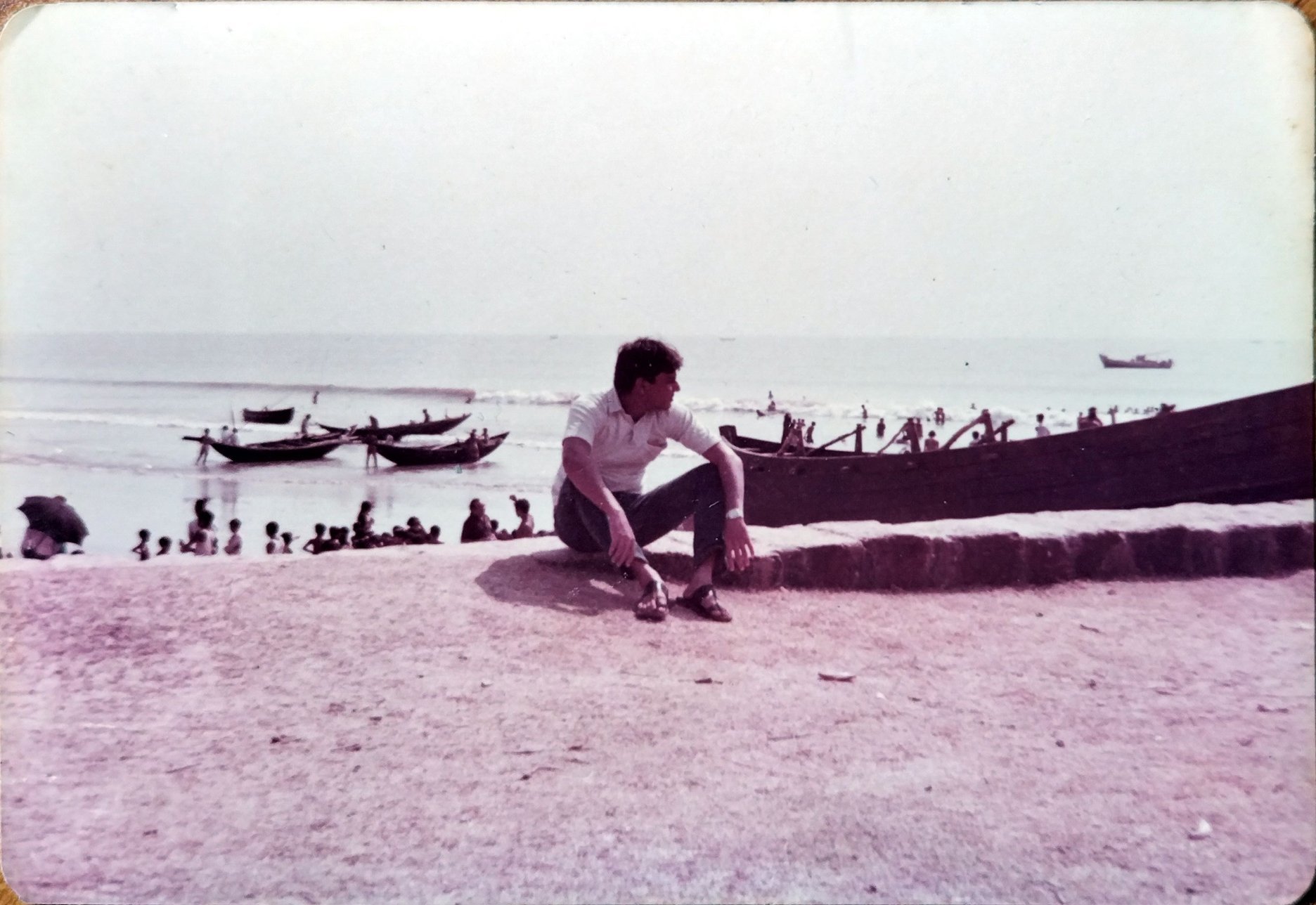Whadda Pav, Vada Pav

The birth of the vada pav coincided with the birth of Shiv Sena. Priyanka Joshi traces the political history of Mumbai’s most beloved street snack.
A black netted gate stands between the two men and a swarm of children; smoke on one side, clamouring hands on the other. The men are trying to pay attention, but there are too many voices, the mass of children now indistinguishable; sweat, voices and beige uniforms blurring. It is 10 minutes until break ends, and Narayan, St. Anthony School’s resident vada pav seller, still hasn’t noticed me. I could leave right now and eat the khichdi that the school offers, but I choose to persist in this battle. “It’s worth it,” I remind myself. It has been four years since I graduated school, and I stand by my words.
Vada pav, an item that has come to represent not just potatoes as the best vegetable (no biases), but also a city, it’s people, and their culture. Mumbai’s most iconic snack is far more than mere sustenance. It is a cultural product shaped by histories and hierarchies that ultimately define the identities of both, those who consume it and those who don’t.
Funnily enough, much like most of Mumbai’s population, the ingredients that constitute vada pav are migrants to the city as well. Along with poverty and partition, colonialism gifted India with potatoes and pav, via the Portuguese. The batata vada however, is a Maharashtrian invention, with the aloo tikki being a close cousin from the North of India.
Surprisingly, the birth of the vada pav coincided with the birth of Shiv Sena, a regional right-wing party. Unsurprisingly, this intersection influenced what vada pav came to mean and represent. This creation of the vada pav was inspired by Shiv Sena head honcho Bal Thackeray’s call to mobilise Maharashtrians into becoming entrepreneurs. On a fine day in 1966, outside Dadar Station, Ashok Vaidya decided to carry out the simple, yet genius act of placing a batata vada in a single split pav and garnishing it with a garlic and coriander chutney, with a side of fried green chillies. Voila! The 25 anna meal was born.
The vada pav was an instant hit in Bombay, a city that consisted largely of students, immigrants and mill workers. It appealed especially to mill workers who worked 10-hour work shifts and didn’t have the time or privilege to prepare and consume full-fledged meals. Moreover, since the stall was located close to Dadar railway station, it was easily accessible to the workers, who used the local train for their daily commute. The vada pav was a success because it was a blend between the familiar and the innovative; it was a roti–sabji meal repackaged, could be eaten on the go, and it was easy on the pocket. In addition, it was vegetarian and allowed room for customisation based on how much chutney one added. Essentially it reflected the ‘never stop’ attitude of the city.
Image credit: India Food Network
Parallel to the rise of the vada pav in Bombay, was the growth of the Udupi restaurants in the city. These restaurants borrowed their moniker from the city of Udupi in Karnataka, where the Krishna Temple was famous for its daily mass meals. This temple cuisine was brought to Bombay with the first Udupi restaurant ‘Udupi Sri Krishna Boarding,’ established in 1942. The restaurant served two meals a day, consisting of rice with a side of south Indian delicacies like rasam and sambar, along with pickles and chutneys. Unlike Sri Krishna Boarding, other Udupi restaurants primarily served rice-based ‘tiffin’ snacks such as dosas, uttapam, idli and vade. Moreover these restaurants were strictly vegetarian, inspired as they were by temple cuisine. As such, the Udupi restaurants gained immense popularity, and by the 1970’s the city was home to a myriad of these restaurants serving fresh, inexpensive, vegetarian meals to a working populus. The number of Udupi restaurants also increased considerably as ownership expanded from Shivalli Brahmins to non-Brahmin castes like the merchant class of Shettys.
Along with the vada pav, the etching of Udupi restaurants into Mumbai’s culture had begun, and the Shiv Sena didn’t plan to let it go unnoticed. Through his speeches, Thackeray addressed issue of unemployment among Maharashtrian youth, blaming it on the increasing South Indian immigrant population. Adopting the tried, tested and successful trope of vote bank politics, Thackeray issued the ‘Bajao pungi, hatao lungi’ campaign, championing the ‘sons of soil’ movement. The campaign was extremely crucial, as it was anchored in differences between the two cultures, choosing the lungi as an identifier of South Indian culture rather than a dhotar, which is donned by upper caste men such as priests and scholars. Moreover, the pungi appealed to the Maharashtrian identity as it is an instrument native to the state. Hence, the lungi became a symbol of South India, and the one who wore it, an outsider.
In the past, such differences in culture were used for divisive politics. Perhaps, one of the goriest examples is the Parsley Massacre that took place on the border between the Dominican Republic and Haiti. Dominican soldiers carried a sprig of parsley and would ask people suspected of being Haitian to pronounce the Spanish word for it: Perejil. Those whose first language was Haitian Creole found it difficult to say it correctly, a mistake that could cost them their lives.
Taking a leaf out of the Dominican soldier's book, Thackery decided to incorporate the vada pav into the concept of Mumbai that he was selling. Thackery added a political element to this widely loved dish, pitting it against Udupi restaurants, and creating an ‘opposition’, an ‘other’; an ‘outsider’. Doing this, he departed from the notion of Mumbai as a cosmopolitan city, but also sent out a clear message against the existence and performance of pluralistic identity — if one were to come to Mumbai they had to conform to its culture in totality; there was no space for the original cultural identity of immigrants. This ideal of a singular dominant ‘Maharashtrian’ identity was epitomised by the fact that the Shiv Sena launched a similar attack against North Indian immigrants later on. It didn’t matter who the outsiders were, who they were not was a more serious concern.
Alongside the Shiv Sena’s ascent into Maharashtra politics, was the fall of the textile mills. The 1970’s and 80’s were troubling times for mill workers, with constant strikes, and the Shiv Sena acted as a friend in need, adding another layer to the nuance of the vada pav: an employment opportunity. The Shiv Sena introduced a scheme wherein they would use their influence to bypass the need for a license, and set up a stall for laid-off factory workers in return for a few rupees. Soon, this resulted in a class of stall owners indebted to the party. The Shiv Sena sounded an age-old idiom: Don’t bite the hand that feeds you — to create a vote bank for itself.
Finally, with the shutdown of factories in 1982, and the victory of the Shiv Sena in the municipal corporation elections in 1985, the sale of vada pav for political propaganda became legitimised. The vada pav was incorporated fully into the Mumbai identity, which now represented only the Shiv Sena’s idea of Maharashtrian culture, and not the largely diasporic population it housed. There was no space for discussion when it came to the identity of a Mumbaikar — not following it meant being termed an ‘outsider’.
This imposition of identity is a crucial aspect of political power play; it has been recognised time and again as a trope used to divide and oppress. For instance, in Denmark, pork was mixed with politics by creating a narrative that represented pork as inherent to Danish culture, associated with Danish values, while propagating anti-nationalist rhetoric against Muslims who aren’t permitted to consume pork according to religious teachings.
In 1995, the Shiv Sena-BJP alliance came to power in Maharashtra and soon after, Bombay was rechristened as Mumbai to better reflect the city’s Marathi heritage. Close on the heels of this win was the announcement and subsequent release of the Zunka Bhakar scheme, and yet again, politics and food were combined. Under this scheme, 2000 stalls were set up in Maharashtra to sell the staple diet of Zunka bhakar at the cost of 1 rupee, so that cost-effective meals could be made available to the working class. However, the scheme failed in achieving its objective and consequently was scrapped by the Congress-NCP government in 2000.
But the affair between Shiv Sena and the vada pav was far from over. In 2009, the Shiv Sena introduced Shiv Vada — a chain of vada pav stalls across the city, in an attempt to revitalise their vote bank. Ironically, the Sena sought help from McDonald’s, a non-Maharashtrian fast food chain on food storage strategies. Although party officials stated that the Shiv Vada was a ‘social movement’ rooted in the desire to increase employment in the city, one couldn’t ignore the political flavour of the move. The choice of endorsing the vada pav because ‘it is Marathi culture’ wasn’t a chance decision, as it conveniently excluded the increasing migrant population in the city. It was in fact, a declaration of the same ideology that the Sena proclaimed from the 1960’s onwards — Mumbai was for the Marathi manoos alone, and no one else qualified.
However, Shiv Vada hit a wall in 2016, when the Mumbai High Court ordered the BMC to shut down all Shiv Vada stalls, stating that they were illegal. Undeterred, the Shiv Sena came up with a simple solution — whitewash the Shiv Vada trademark off the stalls. Since the stalls didn’t have the Sena trademark anymore, BMC officials countered that they couldn’t demolish these establishments.
And so, the vada pav lived on. Happily ever after.
The vada pav is a memoir penned by Mumbai, to Mumbai. But it is much more than the 25 anna meal it was created as. It transformed with every transformation that the city underwent and reflected the growth and regression Mumbai experienced. In the half a century that it has lived, the vada pav has worn multiple hats — it was a tool for political propaganda, a means of employment, the basis for several capitalistic ventures, and most importantly, the working man’s meal.
Priyanka Joshi is currently pursuing a Bachelor of Arts in Psychology and Anthropology from St. Xavier's College, Mumbai. She's an intersectional feminist and her interests include writing, reading, and cooking (or at least trying to).
Banner image: Cook with Renu
ALSO ON THE GOYA JOURNAL








